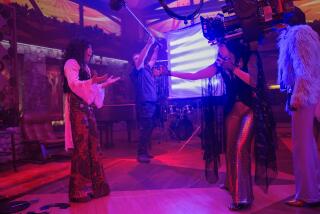Review: New books on Salemâs trials and modern pagans offer bewitching reading this Halloween season
In âThe Witches: Salem, 1692,â a masterful account of the epidemic of paranoia and religious fervor that overcame residents of Essex County in the Massachusetts Bay Colony, Pulitzer Prize winner Stacy Schiff takes on âAmericaâs tiny reign of terror,â the Salem witch trials. Most Americans know of the trials only through fictional accounts like Nathaniel Hawthorneâs âHouse of the Seven Gablesâ or Arthur Millerâs play âThe Crucible,â which conflated Salemâs vicious persecutions with those of the McCarthy era. Schiff painstakingly reconstructs not just the events of 1692 but the world that birthed them: Puritan New England, where Wabanaki raids and massacres were common, food scarce, and the winter darkness inescapable for months on end.
Her accomplishment is all the more remarkable because there are no records of the court sessions â Schiff sifted through archival material as well as historical accounts written by witnesses years after the epidemic.
All mention of the hangings were omitted or expunged from Salemâs official records; the court transcripts were supposedly destroyed in a 1765 fire. An exception is the evidence of witches, which included accounts of luminous jellyfish coming down the chimney, talking cats, satanic visitors, magic apples, and nocturnal flights over the Essex countryside.
The crisis began in the household of the Salem village minister, 30-year-old Samuel Parris. Salem village (the site of present-day Danvers) consisted of 90 isolated families, at a time when Boston had only 8,000 residents and the entire population of New England âwould fit into Yankee Stadium.â
Salemâs villagers were a disputatious bunch, and Parris, their fourth minister, seems to have been unpopular â in 1691, his congregation voted not to collect his salary. Parris had grown up in an affluent merchant family in Barbados; he had no prior pastoral experience when he took the pulpit in 1689, for reasons that remain murky. Providing the incubator for an epidemic of witches was probably not among them.
Parris and his wife lived with their three children in a crowded household that included Parrisâ 11-year-old niece, Abigail, and two Indian slaves, Tituba and her husband, John Indian. Sometime near the end of January 1692, first Abigail and then Parrisâ 9-year-old daughter Betty began to act out: twitching, babbling, leaping into the air and pretending to fly. Salemâs Puritans had few amusements besides cultivating spite and nursing a grievance â no festivals or holidays enlivened the bitterly cold winters. Within weeks, the antics of the children fulfilled the role of reality TV, with as many as 50 visitors crowding the Parris house to gape at the girls.
A month after the onset of Abigailâs frenzy, Mary Sibley, a neighbor, watched the children while the Parrises were away. In their absence, Sibley decided to employ kitchen witchery to discern who or what had possessed the girls. She ordered John Indian to make a cake, mixing the girlsâ urine with rye flour, and fed the resulting mess to the family dog. Parris was understandably enraged when he found out, but the damage was done.
A few days later, Abigail and Betty made the first false accusations of witchcraft. The devil began his rampage through Essex County.
More adolescent girls and two adult women joined ranks with Abigail and Betty, writhing as they jabbed accusatory fingers at those assembled in the courtroom. Neighbors accused neighbors, family members each other. Under questioning by a bench whose members presumed guilt, 55 people admitted that they were witches. The youngest confessor was 5 years old and spent nine months shackled in jail before her release. Her mother, a bellicose beggar imprisoned with her daughter and a newborn infant, was among the first to be executed.
By the time the epidemic ran its course late that year, 20 innocent people were dead. Among those executed were a highly respected, devout mother of seven, and an engaging minister accused of being a wizard. He recited the Lordâs Prayer before he was hanged, moving onlookers to tears.
Schiff dispels some common misconjectures about the trials, and ferrets out intriguing facts. Those thought to be witches were usually not people of color. Half of the Salem girls who were possessed were refugees or had been orphaned by the French-Indian wars. The median age of the accusers was 19, and well-educated girls were more likely to be major players â they would have read the gruesome captivity narrative of Mary Rowlandson, a bestseller of its time, as well as what Schiff calls âmartyrdom porn,â literary sources awash in blood, torment and demons.
Longtime border disputes between neighbors seem to be another instigation for the mass hysteria, along with the brutal weather and steady diet of hellfire preaching that provided jolts of lurid energy in an unbearably bleak environment. But ultimately, as Schiff puts it, âSalem is in part the story of what happens when a set of unanswerable questions meets a set of unquestioned answers.â
And only one person taking the stand points out what the exasperated parent of any modern teenager would know: âWe must not believe all that these distracted children say.â
Compared with Salemâs punitive, backbiting Puritans, the real-life pagans and Wiccans who populate Alex Marâs entertaining âWitches of Americaâ are a cheerful bunch, even if they indulge in the occasional blood offering. Marâs 2010 documentary âAmerican Mysticâ followed three devotees of alternative religions. In âWitches of America,â she continues and enlarges upon that quest: âI want to understand the strange confidence necessary to climb onto the roof and sing to the moon, or to write out commands in your own blood ⌠I want to grasp the moment when that confidence becomes conviction âŚâ
Her journey takes her back to one of the documentaryâs subjects, a young woman named Morpheus whose practice is centered on a Celtic battle goddess who often takes corvid form. Mar also travels to New Orleans in search of âthe heavier stuffâ practiced by adherents of Aleister Crowleyâs darker strain of âmagick,â and to PantheaCon, an annual convention attended by thousands of pagans. There Mar encounters BNPs (Big Name Pagans) with rock star charisma and entourages.
âDo you ever get people you think want to be your new friend,â one BNP wonders, âand then instead you realize theyâre just hanging around waiting to ask for an initiation?â
Mar is an often amusing guide to the household altars and henges of 21st century paganism, in which Wiccans conduct classes via Skype and online distance learning. But what will resonate most with readers is her genuine and touching search for transcendence, which leads to a conviction that all of these strands of belief are âstrategies for staying alive. Some are simply more elaborate and inexplicable than others.â
Handâs most recent novel is âWylding Hall.â
::
The Witches: Salem, 1692
Stacy Schiff
Little, Brown: 512 pp, $32
Witches of America
Alex Mar
Sarah Crichton Books/Farrar, Straus and Giroux: 274 pp, $26
More to Read
Sign up for our Book Club newsletter
Get the latest news, events and more from the Los Angeles Times Book Club, and help us get L.A. reading and talking.
You may occasionally receive promotional content from the Los Angeles Times.







